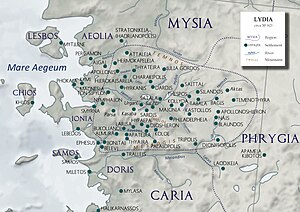Mastaura (Caria)
Mastaura | |
|---|---|
| Coordinates: 37°57′23″N 28°20′30″E / 37.956332°N 28.341756°E | |
| Country | Turkey |
| Province | İzmir |

Mastaura (Ancient Greek: Μάσταυρα), was an ancient Greek town near Dereağzı, Nazilli in northern Caria, not to be confused with ancient Mastaura (Lycia).
Some sources speak of the town as originally belonging to Lydia, a kingdom into which Croesus (560-546 BC) briefly incorporated Caria.[1][2]
Pliny the Elder mentions the town as dependent on Ephesus as its provincial capital and thus as belonging in his time (1st century AD) to the Roman province of Asia[3] which, under the Roman Empire, incorporated Caria.
In Severan times the city became rich as evidenced by the impressive buildings.[4]
Location
[edit]Mastaura was situated in the north of ancient Caria, at the foot of Mount Messogis, on the small river Chrysaoras, between Tralles and Tripolis.[5][6]
The geographer Strabo mentions the town as being in the valley of the Maeander River.[7]
Its site is located near Mastavra in Asian Turkey.[8][9] On 16 October 1836, William Hamilton visited the ruins, then overgrown with ilex trees, brush and brambles.[10]
Remains
[edit]Recently the remains of a Roman-era amphitheatre dating from about 200 AD[11] and holding up to 20,000 spectators have been discovered still standing to a considerable height.[12] It is only the third amphitheatre to be found in Turkey.
Coinage
[edit]Mastaura had the privilege of having a mint and some of its coins are extant.[5][2]
Bishopric
[edit]Le Quien assigns to the city four named bishops. Theodosius attended both the Council of Ephesus in 431 and the Robber Council of Ephesus in 449. His replacement Sabatius asked Bishop Hesperius of Pitanae to represent him at the Council of Chalcedon in 451. Theodorus took part in the Third Council of Constantinople in 680. Constantinus was one of the fathers of the Second Council of Nicaea in 787.[13] To these four may be added a Baanes who was at the Photian Council of Constantinople (879), but it is unclear whether he was bishop of Mastaura in Asia or of Mastaura in Lycia.[14]
No longer a residential bishopric, Mastaura in Asia is today listed by the Catholic Church as a titular see.[15]
References
[edit]- ^ Nisbet, Gideon (11 December 2003). Greek Epigram in the Roman Empire: Martial's Forgotten Rivals. Oxford University Press. ISBN 978-0-19-926337-0. Retrieved 11 December 2021 – via Google Books.
- ^ a b "Our objects and artworks". The Fitzwilliam Museum. Retrieved 11 December 2021.
- ^ Pliny the Elder, The Natural History, Book V, chapter 31
- ^ Magazine, Smithsonian; Gershon, Livia. "In Ancient Turkey, Gladiators Fought at This Colosseum-Like Amphitheater". Smithsonian Magazine. Retrieved 11 December 2021.
- ^ a b "Dictionary of Greek and Roman Geography (1854), MAACAH, MASSICYTES, MASTAURA". Perseus.tufts.edu. Retrieved 11 December 2021.
- ^ "Istanbul Guide, "Carie ... Mastaura & Harpasa"". Istanbulguide.net. Archived from the original on 3 March 2016. Retrieved 11 December 2021.
- ^ "Strabo, Geography, Book 14, chapter 1". Perseus.tufts.edu. Retrieved 11 December 2021.
- ^ Lund University. Digital Atlas of the Roman Empire.
- ^ Richard Talbert, ed. (2000). Barrington Atlas of the Greek and Roman World. Princeton University Press. p. 61, and directory notes accompanying. ISBN 978-0-691-03169-9.
- ^ Hamilton, William John (11 December 1842). "Researches in Asia Minor, Pontus and Armenia: With Some Account of Their Antiquities and Geology". J. Murray. Retrieved 11 December 2021 – via Google Books.
- ^ "Encuentran un anfiteatro romano en la antigua ciudad de Mastaura en Anatolia". Terraeantiqvae.com. Retrieved 11 December 2021.
- ^ Laura Geggel (20 April 2021). "Gladiator arena from Roman era unearthed in Turkey". Livescience.com. Retrieved 11 December 2021.
- ^ Le Quien, Michel (1740). Oriens Christianus, in quatuor Patriarchatus digestus: quo exhibentur ecclesiæ, patriarchæ, cæterique præsules totius Orientis. Tomus primus: tres magnas complectens diœceses Ponti, Asiæ & Thraciæ, Patriarchatui Constantinopolitano subjectas (in Latin). Paris: Ex Typographia Regia. cols. 703–704. OCLC 955922585.
- ^ Pascal Culerrier, Les évêchés suffragants d'Éphèse aux 5e-13e siècles, in Revue des études byzantines, vol. 45, 1987, p. 157
- ^ Annuario Pontificio 2013 (Libreria Editrice Vaticana 2013 ISBN 978-88-209-9070-1), p. 925
![]() This article incorporates text from a publication now in the public domain: Smith, William, ed. (1854–1857). "Mastaura". Dictionary of Greek and Roman Geography. London: John Murray.
This article incorporates text from a publication now in the public domain: Smith, William, ed. (1854–1857). "Mastaura". Dictionary of Greek and Roman Geography. London: John Murray.
Text is available under the CC BY-SA 4.0 license; additional terms may apply.
Images, videos and audio are available under their respective licenses.

